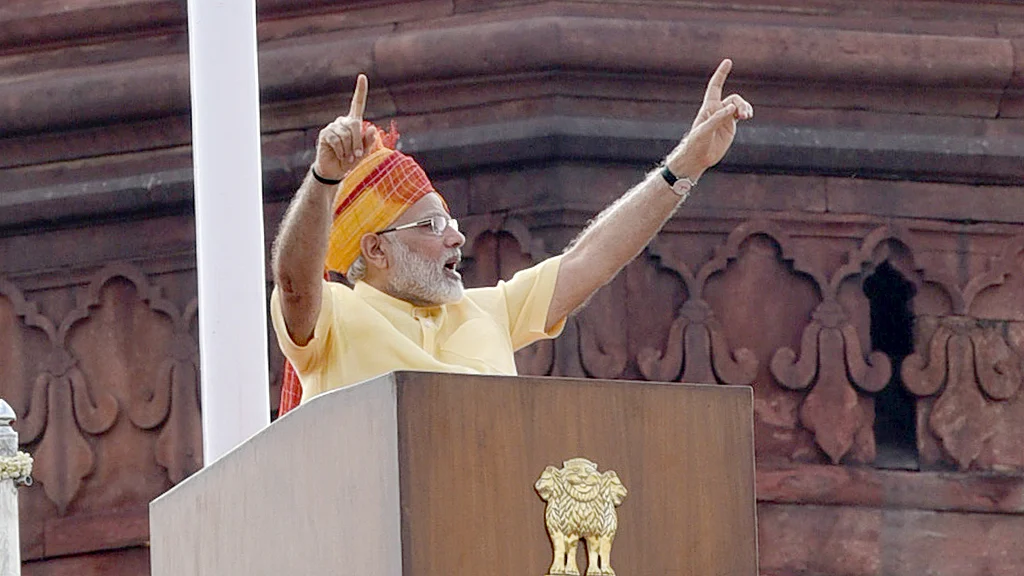Reading between the lines: Modi’s 2017 Independence Day speech
Modi took the opportunity again to peddle dreams in the garb of promises; he is counting on the longevity of people’s gullibility

Prime Minister Narendra Modi’s 2017 Independence Day speech from the pulpit of Red Fort has not just been his shortest at 56 minutes, it has also some marked changes that may provide an insight into how the Hindutva posterboy wishes to cement his position in the 2019 general elections.
Cornered by the rising number of incidents of lynching by gau goons, the death of over 70 children in Gorakhpur and a fledgling economy with virtually no job growth, Modi was well aware that the massive anti-incumbency mandate that he could exact in 2014 may be extremely tough to replicate in 2019. Hence, the tone has been one of subtle nervousness and reconciliation.
He started his speech by remembering those men and women who fought for India’s freedom. After that, a message of solidarity with the dead children’s families in Gorakhpur and those families affected by floods throughout the country followed.
The next utterance was interesting with Modi remembering the Quit India Movement and the Champaran Satyagraha. Now those who are conversant with the history of the freedom struggle will know that the RSS had no role to play in any freedom movement and, in fact, tried its best in resisting the Quit India Movement. “Our country showcased a collective power between 1942 to 1947, let us show the same power and commitment over the next 5 years,” he said. Was he trying to deny history here?
This, however, should not be seen as a departure but rather a continuation of Modi’s long-standing plans of appropriation of Gandhi’s legacy and negation of the Indian National Congress’ contribution to the freedom movement.
He said: “We will not tolerate violence in the name of faith. Before freedom, the slogan was 'Bharat chhodo (Quit India). Today, it should be 'Bharat Jodo' (Bring India together).”
This clearly shows that vigilantism by gau goons has hit the image of the government pretty hard and the Prime Minister wanted to send out a strong message not just to the perpetrators but possibly to the state governments which have largely turned a blind eye towards such incidents.
But, possibly knowing that the cow vigilantes did form a crucial part of his core support group, he tried to balance it out by saying that his government was with Muslim women in their struggle against the Triple Talaq system, thus portraying himself as the strongman who has the courage to dismantle a centuries-old Islamic tradition.
The rest of it was on expected lines. Patting the back of his own government for surgical strikes on terrorists (though terrorism shows no signs of abatement), for ‘successful’ implementation of the GST regime (though the medium and small traders are yet to comprehend what has hit them) and demonetisation which he claimed has led to unearthing of about rupees 2 lakh crore worth of black money (against any logic of mathematics or by the RBI’s own admission), he said the crusade against corruption will continue, thus appealing to his ‘shining’ middle class vote bank.
Nonetheless, he acknowledged that his government has failed to handle the Kashmir situation when he said, “Neither gaali (abuse), nor goli (bullet) will bring a change. The change will take place when we embrace every Kashmiri.” This runs contrary to the Centre’s strong arm tactics which have not led to any positive outcome.
“We are nurturing our youngsters to be job creators and not job seekers,” he said without elaborating on how he plans to do it. On this front, his government has fared worse than every other government that has assumed power after liberalisation. An alarming number of youngsters are joining the job-seeking unemployed bandwagon every year. For them, right now, jobs are more important than to know that they are being empowered to create them.
“We are taking the nation on a new track (of development) and are moving ahead with speed,” he claimed. If one looks at all the core sectors of the economy and exports and other economic indicators, one can’t help but wonder which track he was referring to.
“Bihar, Assam, West Bengal, Odisha and the Northeast will be given more attention. They need to grow further,” he said. If the last Budget and the Centre’s way of pitching in when it comes to these states’ efforts to conduct flood relief are any indicators, this clearly is a policy announcement of the future.
“We will create an India where the poor owns a house and has access to electricity and water; an India, where the farmer sleeps in peace and grows his income two-fold by 2022; an India, where young women get opportunities in every field; an India which is free of terrorism, corruption, dynasty politics, communalism and casteism; and finally, an India which is clean and healthy. Let's move together in this path of development,” said Modi.
Again, these are promises and looking at the state of farm income, terror attack statistics, the number of scams being brushed under the carpet, the number of communal clashes and the latest health indicators, one may be even prompted to call this promise not just unrealistic or not in sync with reality but rather as a repetitive trick of trying to peddle dreams.
Modi has been good at selling dreams and many Indians have lapped it up. Modi is counting on the longevity of their gullibility.
Follow us on: Facebook, Twitter, Google News, Instagram
Join our official telegram channel (@nationalherald) and stay updated with the latest headlines